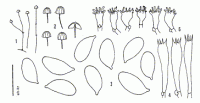|
 Marasmius pallenticeps Marasmius pallenticeps
BiostatusPresent in region - Indigenous. Non endemic
Images (click to enlarge)
Caption: Fig. 5 (1-5). Marasmius pallenticeps Singer (ZT 1113).- 1. Basidiomes.- 2. Basidiomes (x4).-3.
Basidiospores.-4. Basidia-5. Pileipellis. |
Article: Desjardin, D.E.; Horak, E. (1997). Marasmius and Gloiocephala in the South Pacific Region: Papua New Guinea, New Caledonia, and New Zealand taxa. Bibliotheca Mycologica 168: 152 p.
Description: Pileus 1.5-3.0 mm diam, hemispherical to convex throughout maturation, disc flat or
depressed, with an acute, conical papilla, margin weakly plicate; surface dull, dry, minutely
pruinose; off white to cream with a fuscous papilla. - Lamellae collariate, distant to remote (5-7),
lamellulae absent, white; edges subfimbriate, white.- Stipe 10-25 x 0.2-0.3 mm, central, equal, wiry,
glabrous, tough, arising directly from black rhizomorphs or erumpent from substrate, often with 1 or
more V-shaped nodes along length of stem or at the base; apex white, blackish brown elsewhere.-
Odor and taste not distinctive.
Basidiospores 8.0-10.5 x 4.5-5.5 µm, ellipsoid, smooth, thin-walled, hyaline, inamyloid.- Basidia
30-36 x 5-7 µm, cylindrical to subclavate, 4spored, clamped.- Cheilocystidia abundant, of Siccus-type cells, 8-12 x 4-7 µm, hyaline, otherwise similar to the pileipellis cells.- Pleurocystidia absent.-
Pileipellis hymeniform, composed of Siccus-type cells; main body 8-12 x 4-7 µm, subcylindrical to
clavate, hyaline to very pale yellowish brown, thin-walled to slightly apically thick-walled; apical
setulae, 1-4 x 0.5-1.0 µm, irregularly cylindrical, hyaline to pale yellowish brown; cells from papilla
thick-walled, brown, with few setulae.- Pileal and lamellar trama inamyloid.- Stipe tissue
monomitic; cortical hyphae parallel, cylindrical, smooth, brown, dextrinoid; medullary hyphae
similar but paler, dextrinoid.- Caulocystidia absent.-Clamp connections present.
Habitat: Habit, habitat and distribution.- Solitary, in groups on rotting leaves of Beilschmiedia taraire
(Lauraceae). Argentina, New Zealand.
Notes: Marasmius pallenticeps, described originally from material collected in Argentina, is characterized
by tiny, white pilei with a prominent fuscous papilla, distant (5-7) collariate lamellae with white
edges, a relatively long (10-25 mm) black stipe that arises directly from rhizomorphs and has one or
more V-shaped nodes along its length or at its base, relatively large basidiospores, and small Siccus-type pileipellis cells and cheilocystidia. Marasmius pallenticeps belongs in sect. Marasmius subsect.
Sicciformes.
There are a number of species with tiny, white pilei with dark central papilla whose basidiomes are
formed directly from rhizomorphs, including M. multiceps Berk. & M. A. Curtis from Cuba and
Central America and M. cupressi formis Berk. from Brazil and Zaire. Marasmius multiceps differs
in forming more numerous lamellae (9-16), smaller basidiospores (6.0-8.5 x 2.0-3.5 µm), and
Rotalis-type pileipellis cells 9.0-12.5 µm diam (Isotype FH!). Marasmius cupressiformis differs in
forming much shorter stipes (1-4 mm long), smaller basidiospores (6.0-8.5 x 3.5-4.5 µm), and two
types of pileipellis cells, viz. broad Rotalis-type cells and Siccus-type cells with long (2-15 µm),
thick-walled setulae (fide Singer, 1964, 1976). In addition, there are several other species that form
stipes with V-shaped nodes in combination with tiny basidiomes arising directly from rhizomorphs,
including M. polycladus Mont. from French Guyana, M. trichorhizus Speg. from Paraguay, M.
hippiochaetes Berk. from Brazil, and M. schultesii Singer from Colombia. All of the latter species
differ from M. pallenticeps in forming darkly pigmented pilei (red, brown, brownish purple),
and different sized basidiospores. Moreover, M. hippiochaetes and M. schultesii form hirsute
rhizomorphs with setiform hairs.
|